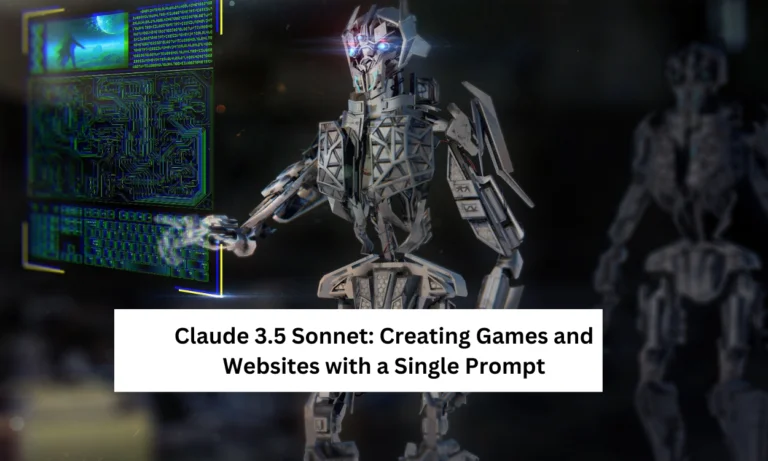Claude 3.5 Sonnet: Creating Games and Websites with a Single Prompt.In the rapidly evolving landscape of artificial intelligence, Claude 3.5 Sonnet stands out as a remarkable advancement in language models. As part of the Claude 3 family developed by Anthropic, this AI assistant has demonstrated unprecedented capabilities in various domains, including the creation of games and websites through simple text prompts. This article explores the revolutionary potential of Claude 3.5 Sonnet in game development and web design, offering insights into its capabilities, limitations, and the implications for these industries.
Understanding Claude 3.5 Sonnet
Overview of the Claude 3 Family
The Claude 3 family represents Anthropic’s latest generation of AI language models. It includes three main variants:
- Claude 3 Haiku: Optimized for speed and efficiency
- Claude 3 Sonnet: Balanced performance for a wide range of tasks
- Claude 3 Opus: The most powerful variant, capable of handling complex and specialized tasks
Key Features of Claude 3.5 Sonnet
Claude 3.5 Sonnet, an upgraded version of Claude 3 Sonnet, boasts several impressive features:
- Enhanced natural language understanding
- Improved context retention
- Advanced reasoning capabilities
- Creativity in generating ideas and content
- Ability to understand and generate code in multiple programming languages
How Claude 3.5 Sonnet Differs from Previous Versions
Compared to its predecessors, Claude 3.5 Sonnet offers:
- Increased accuracy in task completion
- Better handling of ambiguous or complex prompts
- More nuanced understanding of context and subtext
- Improved ability to generate coherent and creative outputs
Creating Games with Claude 3.5 Sonnet
Types of Games Claude 3.5 Sonnet Can Create
Claude 3.5 Sonnet demonstrates remarkable versatility in game creation, capable of generating concepts and code for various game types:
- Text-based adventure games
- Simple 2D platformers
- Puzzle games
- Turn-based strategy games
- Interactive fiction
The Process of Game Creation Using Claude 3.5 Sonnet
Creating a game with Claude 3.5 Sonnet typically involves the following steps:
- Providing a detailed prompt describing the desired game
- Refining the concept through iterative conversations with the AI
- Generating game mechanics and rules
- Creating storylines and character descriptions
- Producing code snippets or full scripts for game implementation
Example: Creating a Text-Based Adventure Game
Let’s explore how Claude 3.5 Sonnet might approach creating a text-based adventure game:
- Initial prompt: “Create a text-based adventure game set in a mysterious abandoned space station.”
- Claude 3.5 Sonnet generates a basic game structure, including:
- Setting description
- Main character background
- Key locations within the space station
- Puzzles and challenges
- Multiple story endings
- The user refines the concept through follow-up prompts
- Claude 3.5 Sonnet produces Python code for game implementation
Advantages of Using Claude 3.5 Sonnet for Game Creation
- Rapid prototyping of game ideas
- Access to a wide range of creative concepts
- Ability to generate both game design and code simultaneously
- Potential for unique and unexpected game mechanics
- Reduced time and resources needed for initial game development
Limitations and Challenges
While Claude 3.5 Sonnet offers impressive capabilities, it’s important to note some limitations:
- Generated code may require refinement and debugging
- Complex game mechanics might be challenging to fully implement
- The AI’s understanding of game balance and player experience may be limited
- Legal and ethical considerations regarding AI-generated content
Creating Websites with Claude 3.5 Sonnet
Types of Websites Claude 3.5 Sonnet Can Design
Claude 3.5 Sonnet demonstrates proficiency in conceptualizing and coding various types of websites:
- Personal portfolios
- Business landing pages
- E-commerce sites
- Blogs and content-driven websites
- Simple web applications
The Process of Website Creation Using Claude 3.5 Sonnet
Creating a website with Claude 3.5 Sonnet typically involves:
- Providing a detailed prompt describing the desired website
- Discussing and refining the website’s purpose, target audience, and key features
- Generating a sitemap and basic information architecture
- Creating HTML, CSS, and JavaScript code for the website
- Suggesting content structure and placeholder text
Example: Designing a Personal Portfolio Website
Let’s explore how Claude 3.5 Sonnet might approach creating a personal portfolio website:
- Initial prompt: “Design a personal portfolio website for a graphic designer with a minimalist aesthetic.”
- Claude 3.5 Sonnet generates:
- A sitemap including Home, About, Portfolio, and Contact pages
- HTML structure for each page
- CSS for a minimalist design, including responsive layout
- JavaScript for interactive elements, such as a image gallery
- The user refines the design through follow-up prompts
- Claude 3.5 Sonnet produces complete code for the website
Advantages of Using Claude 3.5 Sonnet for Website Creation
- Rapid prototyping of website designs
- Generation of both design concepts and functional code
- Ability to quickly iterate on ideas
- Potential for unique and creative design solutions
- Reduced time and resources needed for initial website development
Limitations and Challenges
While Claude 3.5 Sonnet offers impressive capabilities in website creation, some limitations include:
- Generated code may require optimization and testing
- Complex interactivity or backend functionality might be challenging to implement
- The AI’s understanding of current web design trends and user experience best practices may be limited
- Potential issues with originality and uniqueness of generated designs
The Impact of AI-Assisted Creation on Game Development and Web Design Industries
Democratization of Creation
Claude 3.5 Sonnet and similar AI tools have the potential to democratize game development and web design:
- Lowering barriers to entry for aspiring creators
- Enabling rapid prototyping and idea validation
- Reducing the need for extensive technical knowledge
Changing Role of Developers and Designers
The advent of AI-assisted creation tools may lead to shifts in the roles of human creators:
- Focus on high-level concept development and creative direction
- Increased emphasis on refining and optimizing AI-generated content
- New specializations in prompt engineering and AI collaboration
Ethical and Legal Considerations
The use of AI in creative industries raises several important questions:
- Ownership and copyright of AI-generated content
- Potential job displacement in certain areas of game development and web design
- Ensuring diversity and avoiding bias in AI-generated content
- Maintaining human creativity and originality in the face of AI assistance
Future Prospects and Potential Developments
As AI technology continues to advance, we may see:
- More sophisticated AI models capable of creating complex, AAA-quality games
- AI-assisted creation of fully functional, database-driven web applications
- Integration of AI assistants into popular game engines and web development frameworks
- Collaborative AI systems that can work seamlessly with human teams
Best Practices for Using Claude 3.5 Sonnet in Game and Website Creation
Crafting Effective Prompts
To get the best results from Claude 3.5 Sonnet, consider the following tips for crafting prompts:
- Be specific about your requirements and desired outcome
- Provide context and background information
- Break down complex requests into smaller, manageable parts
- Use clear and unambiguous language
Iterative Refinement
Achieving the best results often requires an iterative approach:
- Start with a broad concept and gradually refine it
- Ask follow-up questions to clarify or expand on generated content
- Provide feedback to guide the AI towards your desired outcome
- Experiment with different phrasings and approaches
Combining AI-Generated Content with Human Creativity
To create truly unique and compelling games or websites:
- Use Claude 3.5 Sonnet as a brainstorming tool and source of inspiration
- Blend AI-generated ideas with your own creative concepts
- Critically evaluate and refine AI-generated content
- Add personal touches and unique elements to differentiate your creation
Verifying and Testing AI-Generated Code
When using code generated by Claude 3.5 Sonnet:
- Always review and understand the generated code
- Test thoroughly for functionality and performance
- Optimize and refine code as necessary
- Ensure compliance with best practices and coding standards
Case Studies: Successful Projects Using Claude 3.5 Sonnet
Game Development Case Study: “Stellar Enigma”
A small indie game studio used Claude 3.5 Sonnet to create “Stellar Enigma,” a text-based space exploration game:
- Initial concept generation and storyline development
- Creation of an extensive galaxy with unique planets and alien species
- Generation of puzzles and dialogue trees
- Basic code structure for game mechanics
The studio refined and expanded upon the AI-generated content, resulting in a critically acclaimed game that blended AI creativity with human storytelling.
Web Design Case Study: “EcoVentures”
A startup environmental consulting firm utilized Claude 3.5 Sonnet to create their website, “EcoVentures”:
- Generation of a responsive, eco-themed website design
- Creation of content structure and placeholder text for services and case studies
- Implementation of an interactive carbon footprint calculator
- Basic SEO optimization suggestions
The firm’s marketing team then customized the content and refined the design, resulting in a professional and engaging web presence that effectively showcased their services.
The Future of AI-Assisted Creation
Potential Advancements in AI Technology
As AI continues to evolve, we may see:
- More sophisticated understanding of game mechanics and player psychology
- Improved generation of complex, interactive web applications
- Better integration with existing game engines and web development frameworks
- Enhanced ability to create and manipulate visual assets
Integration with Other Technologies
The combination of AI-assisted creation with other emerging technologies could lead to:
- AI-generated VR and AR experiences
- Seamless integration with voice assistants for game control and web navigation
- AI-driven procedural content generation in games
- Personalized web experiences tailored to individual users in real-time
Ethical Considerations and Responsible Development
As AI-assisted creation becomes more prevalent, it’s crucial to address:
- Transparency in the use of AI-generated content
- Ensuring diversity and representation in AI-generated games and websites
- Developing guidelines for the ethical use of AI in creative industries
- Balancing AI assistance with human creativity and job preservation
Conclusion
Claude 3.5 Sonnet represents a significant leap forward in AI-assisted creation for games and websites. Its ability to generate complex concepts, storylines, and functional code from a single prompt opens up new possibilities for both amateur creators and professional developers. While the technology still has limitations and raises important ethical questions, it has the potential to revolutionize the way we approach game development and web design.
As we move forward, the key to harnessing the power of AI assistants like Claude 3.5 Sonnet lies in finding the right balance between artificial intelligence and human creativity. By using these tools as aids to amplify our creative capabilities rather than replace them, we can unlock new realms of innovation in game development and web design.
The future of AI-assisted creation is bright, and Claude 3.5 Sonnet is just the beginning. As technology continues to evolve, we can expect even more impressive capabilities that will further blur the lines between human and artificial creativity. It’s an exciting time for creators, and those who learn to effectively collaborate with AI assistants like Claude 3.5 Sonnet will be well-positioned to lead the next generation of digital innovation.

